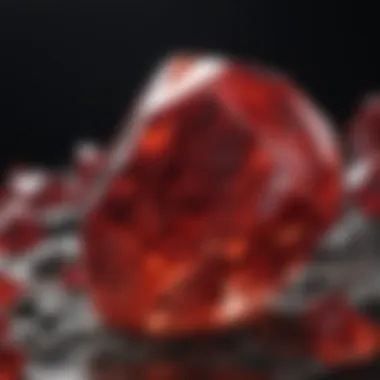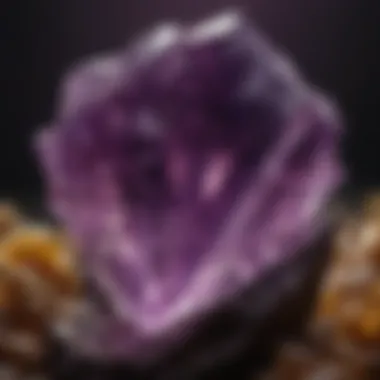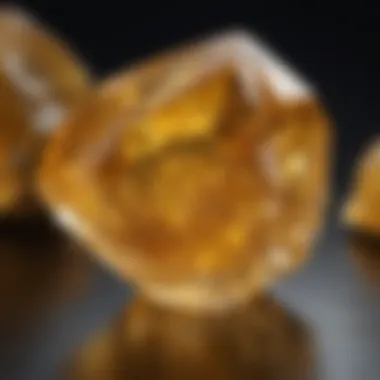Unlock the Secrets: Mastering Crystal Identification by Color


Rock and Fossil Identification
When it comes to identifying crystals by color, rock and fossil collectors must possess a keen eye for detail. Understanding the types of rocks and fossils where crystals can be found is essential. Differentiating between sedimentary, igneous, and metamorphic rocks is crucial, as each type harbors distinct mineral compositions. Fossils, preserved remains of prehistoric organisms, often intertwine with crystals, adding another layer of complexity to the identification process.
To accurately identify crystals by color, collectors should pay attention to specific characteristics. These may include the crystal's hue, transparency, and luster. Additionally, understanding the crystal's physical properties, such as hardness and cleavage, can provide valuable insights into its identity.
Utilizing the right tools for identification is paramount. A magnifying glass or jeweler's loupe can help examine small crystals closely. Specialized kits containing hardness picks and streak plates aid in determining a crystal's hardness and streak color, further assisting in the identification process.
Introduction
In the realm of crystal identification for rock and fossil collectors, understanding the dynamic interplay of color is paramount. Colors within crystals offer intricate clues about their composition, formation, and energetic properties. Unveiling the secrets held within each hue enhances the overall appreciation and knowledge base of enthusiasts. This article serves as a comprehensive guide, shedding light on the significance colors play in the intricate world of crystal identification.
The Importance of Color in Crystal Identification
Color stands as a cornerstone element in the identification of crystals, offering a visual fingerprint of their unique characteristics. Within the world of crystals, color signifies the presence of specific minerals or impurities that influence their overall properties. Delving into the nuances of color provides collectors with essential information regarding the origin, geological conditions, and potential uses of different crystals. Recognizing the importance of color grants collectors the ability to make informed decisions when acquiring new specimens, ultimately enriching their collection and understanding.
Why Color Matters in the World of Crystals
The significance of color in crystal identification lies in its role as a primary indicator of mineral composition and structural arrangement. Different hues signify varying mineral content and potential healing properties, making color a key factor in distinguishing one crystal from another. Understanding the nuances of color allows collectors to differentiate between similar-looking specimens and grasp the subtle variations in crystal formations. By honing their ability to interpret colors accurately, collectors can deepen their knowledge base and foster a deeper connection with the crystals they encounter.
Overview of Crystal Color Classification
Crystal color classification encompasses a spectrum of shades that categorize stones based on their primary and secondary hues. This classification system aids collectors in organizing specimens and recognizing patterns within different crystal families. Understanding the primary colors provides a foundational framework for identifying crystals, while exploring secondary colors and variations expands collectors' awareness of the diverse range of hues found in nature's geological creations.
Primary Colors of Crystals


Primary colors represent the fundamental hues seen in crystals, such as clear, white, blue, green, red, purple, yellow, orange, black, and brown. These colors serve as the base for further exploration into the intricate world of crystal coloration, helping collectors establish a solid foundation for identification.
Secondary Colors and Variations
Beyond primary colors, secondary hues and variations offer collectors a deeper insight into the complexities of crystal coloration. Shades like pink, peach, lavender, and teal add richness to the spectrum of colors found in crystals, providing a broader understanding of the diverse mineral compositions that give rise to these captivating hues. Exploring secondary colors enhances collectors' ability to appreciate the subtle beauty and diversity present within the world of crystals.
Common Crystal Colors and Their Meanings
The section on Common Crystal Colors and Their Meanings is a pivotal aspect of this article, offering rock and fossil collectors valuable insights into the significance of color in crystal identification. Understanding the various hues and their corresponding minerals plays a crucial role in the realm of geological specimen collection. By delving into the common crystal colors and their meanings, readers gain a deeper appreciation for the diverse spectrum found in the world of crystals.
Clear and White Crystals
Quartz
Quartz, a prominent inclusion in the Clear and White Crystals category, boasts exceptional clarity and a wide range of applications in the crystal world. Its key characteristic lies in its versatility, making it a favored choice for collectors seeking beauty and functionality in their specimens. Quartz's unique feature includes its ability to amplify energy and intent, serving as a powerful tool in various practices. While Quartz offers numerous advantages such as clarity and energy enhancement, collectors should be mindful of potential variations in color and transparency that may affect its value.
Selenite
Selenite, another notable crystal in the Clear and White category, contributes a sense of tranquility and mental clarity to the crystal identification landscape. Its key characteristic revolves around its ethereal glow and gentle energy, making it a popular choice for those seeking serenity and spiritual connection. The unique feature of Selenite lies in its self-cleansing properties, offering a convenient way to maintain its purity. While Selenite provides advantages such as promoting peace and clarity, collectors should handle it with care due to its fragile nature.
Blue Crystals
Sodalite
Sodalite stands out in the Blue Crystals section with its rich blue hue and unique marbling patterns, adding a touch of elegance to any crystal collection. Its key characteristic lies in its ability to enhance communication and stimulate creativity, making it a beneficial choice for those seeking inspiration and self-expression. The unique feature of Sodalite includes its connection to the throat chakra, aiding in effective communication and self-expression. While Sodalite offers advantages such as heightened intuition and clarity of thought, collectors should be cautious of potential color variations that may impact its value.
Aquamarine


Aquamarine shines in the Blue Crystals category, capturing the essence of crystalline waters with its soothing blue-green tones. Its key characteristic revolves around its calming energy and association with emotional healing, making it a popular choice for those seeking inner peace and mental clarity. The unique feature of Aquamarine lies in its connection to the sea and its ability to evoke feelings of serenity and tranquility. While Aquamarine provides advantages such as stress relief and enhanced intuition, collectors should be aware of potential inclusions and flaws that may affect its beauty and value.
Green Crystals
Emerald
Emerald, a captivating gem in the Green Crystals section, exudes a sense of lushness and abundance with its vibrant green hues. Its key characteristic lies in its association with love and prosperity, making it a sought-after choice for those seeking growth and renewal in their lives. The unique feature of Emerald includes its rich color saturation and regal allure, symbolizing fertility and rebirth. While Emerald offers advantages such as promoting joy and emotional balance, collectors should be mindful of potential treatments like oiling and enhancement to enhance its appearance and market value.
Malachite
Malachite, a stalwart presence in the Green Crystals category, showcases striking green banded patterns that evoke a sense of nature's mastery. Its key characteristic revolves around its strong protective properties and connection to the earth's energies, making it a valuable choice for those seeking grounding and vitality. The unique feature of Malachite lies in its transformative abilities and power to absorb negative energies, promoting inner strength and perseverance. While Malachite provides advantages such as protection and growth, collectors should be cautious of its high copper content, which may cause skin sensitivity or toxicity if handled improperly.
Factors Influencing Crystal Color
Understanding the factors that influence crystal color is a key component of crystal identification in the realm of geological specimen collection. A crystal's color is determined by various factors, including its mineral composition, trace elements present, as well as how light is absorbed and reflected within its crystal structure. By delving into these influencing elements, rock and fossil collectors can deepen their understanding of crystals and better distinguish one type from another.
Mineral Composition
Crystals exhibit a diverse range of colors due to the unique mineral compositions they possess. The minerals present within a crystal have a direct impact on its color appearance. For example, the presence of iron can impart earthy reds and oranges to crystals, while copper can manifest as vibrant blues and greens. Understanding the mineral composition of crystals is crucial for accurately identifying and appreciating their color variations.
Impact of Trace Elements
Trace elements play a significant role in determining the color hues of crystals. These minute elements, present in small concentrations, can have a profound effect on the overall coloration of a crystal. For instance, the presence of chromium can lead to rich greens in emeralds, while manganese can produce intricate purples in amethysts. The impact of trace elements showcases the intricate chemical processes that contribute to the stunning array of colors found in crystals.
Light Absorption and Reflection


In addition to mineral composition, how light interacts with a crystal's structure also influences its perceived color. When light enters a crystal, it may be absorbed by certain elements within the crystal lattice, altering the wavelength of light that is reflected back to the observer. This interplay between light absorption and reflection dictates the visible color of the crystal.
Role of Crystal Structure
The inherent structure of a crystal affects how light behaves within it. Crystals with varying structures will interact with light in distinct ways, leading to different color manifestations. For example, quartz crystals with their orderly atomic arrangements may exhibit clarity and brilliance, while opal, with its amorphous structure, displays iridescence due to light diffraction. Understanding the role of crystal structure provides valuable insights into the kaleidoscopic world of crystal colors.
Tips for Accurate Crystal Color Identification
In the realm of crystal identification, precise assessment of crystals' colors holds paramount importance for rock and fossil collectors. By delving into the hues of crystals, collectors can discern valuable insights about the mineral composition, rarity, and even potential metaphysical properties of the crystals. Accurate color identification serves as a foundational skill that enables collectors to differentiate between various crystal types, enhancing their overall understanding and appreciation of geological specimens. Through meticulous observation and analysis of color attributes, collectors can uncover the unique characteristics and histories encapsulated within each crystal. Understanding the significance of accurate color identification empowers collectors to build a comprehensive knowledge base and make informed decisions in their crystal collecting endeavors.
Utilizing Natural Lighting
When it comes to crystal color identification, utilizing natural lighting plays a pivotal role in ensuring accurate color representation. Natural light provides a true reflection of the crystal's color, allowing collectors to perceive nuances and undertones that artificial lighting may obscure. The nuanced interplay of natural light on crystal surfaces reveals intricate details and color variations that artificial lighting often fails to replicate. Its unmatched clarity and consistency make natural lighting a preferred choice for crystal examination, providing collectors with an authentic and unadulterated view of the crystals' true colors.
Effect of Artificial Lighting
Artificial lighting, while convenient, can alter the perceived color of crystals due to its artificial spectrum. The specific wavelengths emitted by artificial sources may distort the natural hues of crystals, leading to potential misinterpretations during identification. Understanding the impact of artificial lighting on color perception is crucial for collectors aiming to achieve precise and reliable results in their evaluations. By acknowledging the limitations of artificial lighting and its tendency to skew color accuracy, collectors can minimize potential errors and ensure a more rigorous approach to crystal color identification.
Comparison with Color Charts
In addition to natural lighting, utilizing color charts serves as a valuable aid in the accurate identification of crystal colors. Color charts provide a standardized reference point for categorizing and comparing the colors of crystals, enabling collectors to establish a baseline for their assessments. Through comparison with color charts, collectors can validate their color observations against established references, ensuring consistency and accuracy in their evaluations. This systematic approach enhances the reliability of color assessments, facilitating clearer classification and identification of crystals based on their distinct color profiles.
Color Consistency Evaluation
Color consistency evaluation involves comparing the observed color of a crystal with predefined standards to evaluate its adherence to specific color norms. This method enables collectors to assess the uniformity and intensity of a crystal's coloration, identifying any deviations or abnormalities that may signify unique characteristics or impurities. By conducting color consistency evaluations, collectors can refine their color identification skills and develop a more discerning eye for subtle variations in crystal colors. The systematic process of comparing observed colors with established standards enhances the accuracy and precision of crystal color identification, contributing to a more thorough and insightful analysis of geological specimens.
Conclusion
In this detailed guide on how to identify crystals by color, the conclusion acts as a vital part of the article, emphasizing the significance of understanding crystal diversity. By concluding with a focus on enhancing the crystal collecting experience, readers are encouraged to delve deeper into the world of geological specimen collection. It serves as a reminder of the beauty and complexity embedded within various crystal hues, prompting enthusiasts to appreciate the depth of color variations present in nature. This section reinforces the idea that through learning to identify crystals by color, collectors gain a deeper appreciation for the natural world and the intricate formations that exist within it.
Enhancing Crystal Collecting Experience
- Appreciation of Crystal Diversity: At the core of the crystal collecting experience lies the profound concept of crystal diversity. The appreciation of crystal diversity underscores the fascinating array of colors, shapes, and formations that crystals exhibit, making each specimen unique and intriguing. By showcasing the spectrum of hues crystals can possess, collectors gain a greater understanding of the geological processes that contribute to crystal formation, enriching their knowledge and expanding their collection. The key characteristic of appreciating crystal diversity lies in recognizing the beauty in differences and complexities, fostering a sense of awe and wonder towards the natural world. Embracing crystal diversity not only enhances the visual appeal of a collection but also provides a deeper connection to the Earth's history and geological complexities. This facet of crystal collecting offers a transformative experience, making it a popular choice among collectors seeking to broaden their horizons and deepen their understanding of the world around them.







